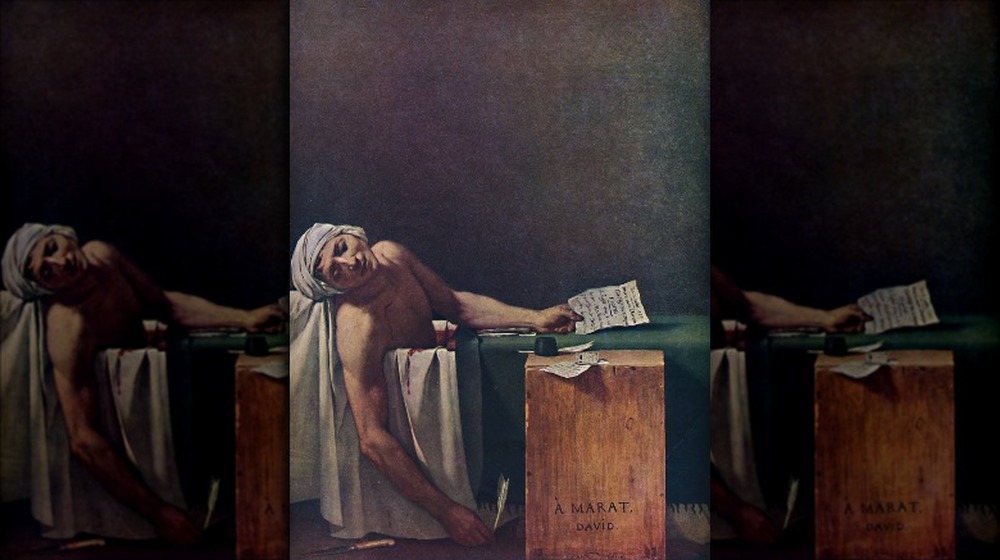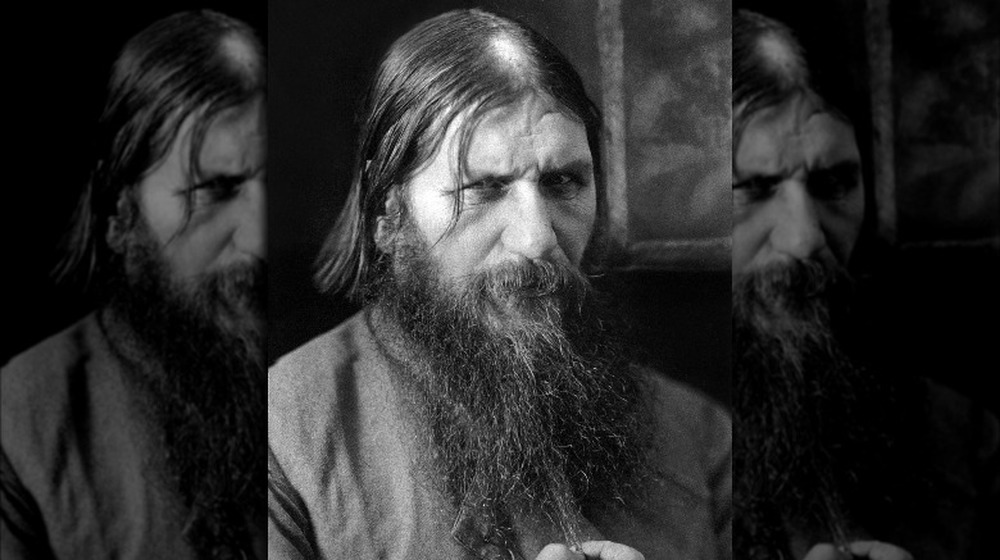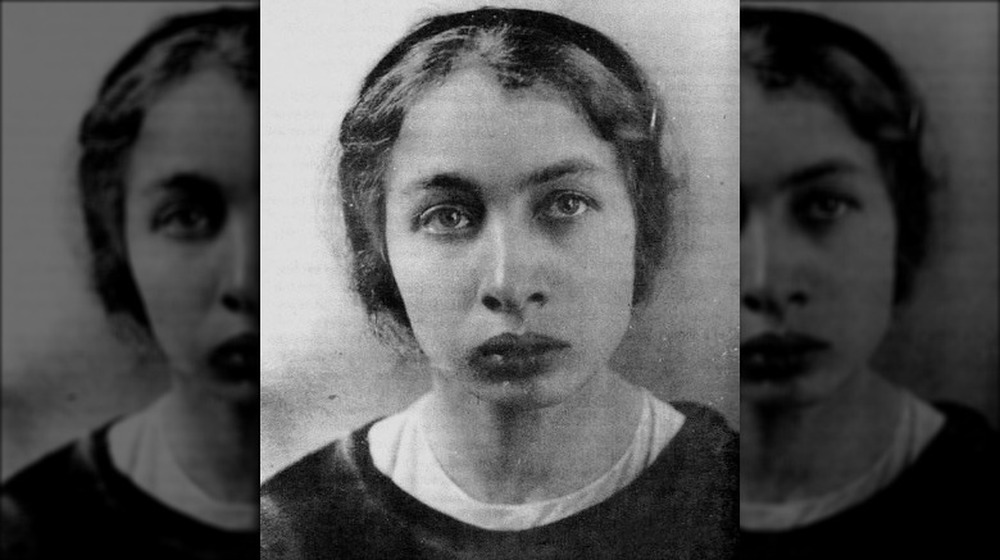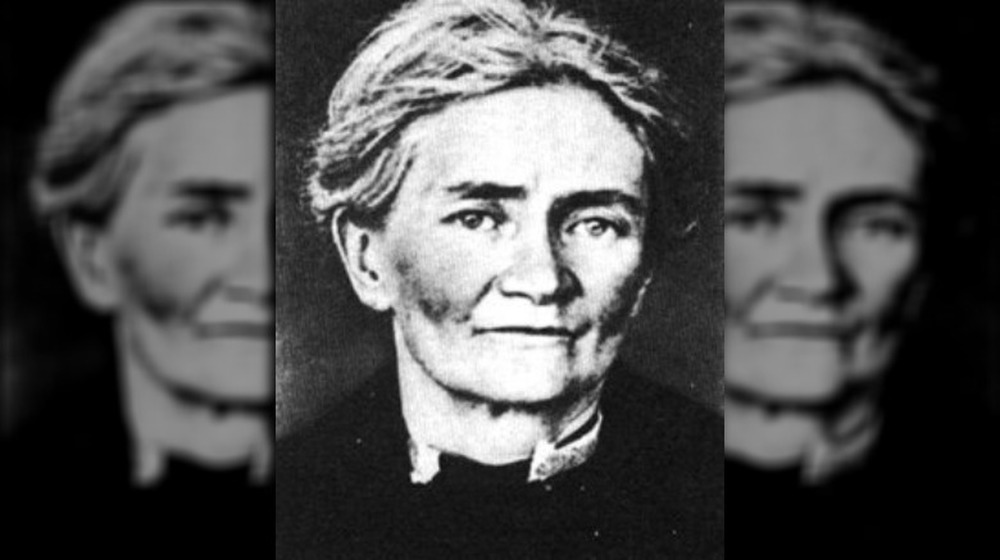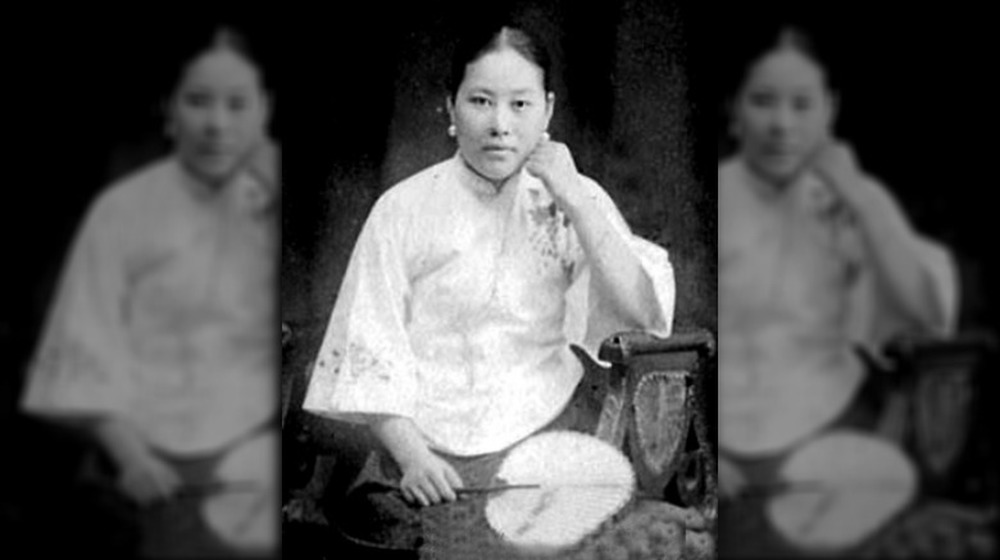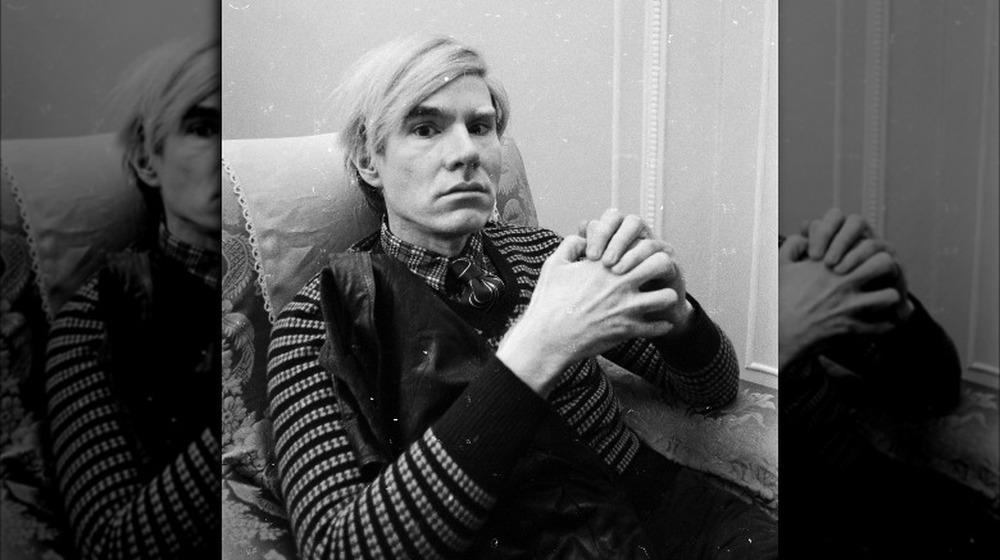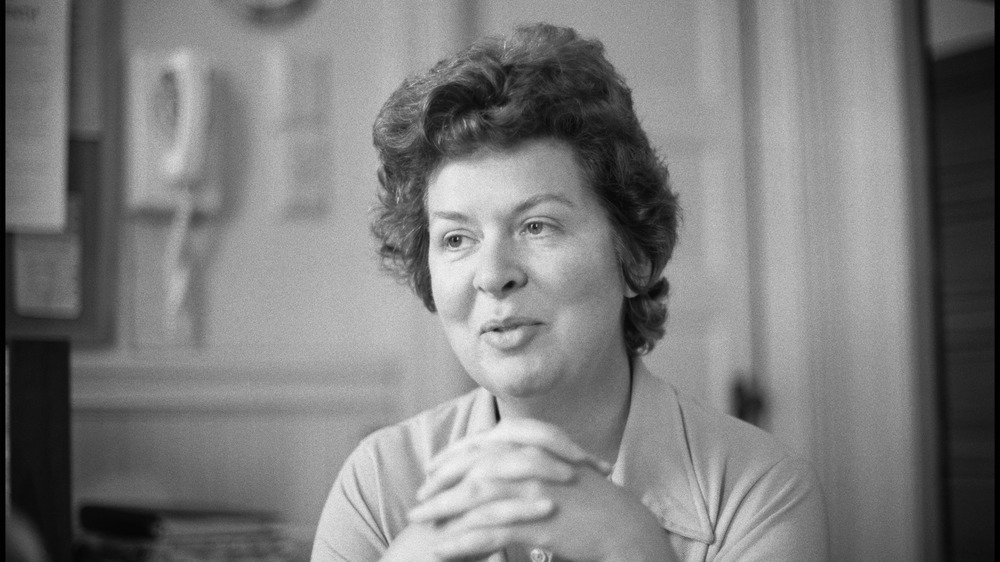The Most Notorious Female Assassins In History
Female assassins have been making it into the movies and onto the television screen a decent bit — and to a pretty positive reception. Black Widow of Marvel fame and Killing Eve's Villanelle are just to name a couple that have really hit popularity of late. But ladies capable of a murder or two aren't only relegated to fiction. Far from it.
Honestly, the reality is a lot more interesting and varied. Female assassins have made it into the history books before, and they each have their own tales to tell, wielding guns, blades, or sometimes poisons against impressively high-profile targets. A lot of the time, those tales are wrapped up in tragedy, but occasionally there's a bit of triumph. Sometimes, the stories are straightforward, but other times, there's a definite air of mystery. In short, there's a lot that happened in the past, and it's fascinating.
Mistress Marcia: a concubine who felled an emperor
Female assassins have been around for a while, and you'd need only look to the Roman Empire to find a significant name. Marcia Aurelia Ceionia Demetrias was a concubine to the Roman Emperor Commodus, says the Oxford Classical Dictionary – and his assassin.
Commodus (pictured above) isn't remembered fondly. His rule ended over eight decades of stability in the Roman Empire (via Britannica). He tried to rename Rome to Colonia Commodiana (Colony of Commodus) and arbitrarily killed off officials. Not a great leader.
That's aside from what happened on the Roman New Year in 192 A.D. Commodus wanted to appear to the people alongside the gladiators, rather than from the palace, as was traditional. Demetrias tried to dissuade him from it, saying he was disgracing the empire (via People Pill). Angered, he placed her name on a list to be executed the next morning. But Demetrias ended up finding that list, vowing that "a fuddled drunkard is not going to get the better of a sober woman" and conspired with two others sentenced to death. She regularly fed him wine after his bath, and they took advantage of that, poisoning the wine. But it only made him violently sick. They had to pay an athlete to strangle him to death.
She ended up marrying one of her co-conspirators, only to be killed a year later.
Charlotte Corday: making a martyr
The French Revolution was a bit of a mess, to say the least. But it's a mess that's been immortalized in art, and one of those pieces — The Death of Marat (pictured above) — comes with quite a story.
Marat was a voice for the radical side of the French Revolution. He rejected much of the social order, calling for the complete fall of the aristocracy while refuting more moderate revolutionaries, including the Girondists (via Britannica). He founded a journal in 1789, which helped bring about the bloody Reign of Terror in 1792 and saw himself as a martyr, says History.
And a martyr he would become. Born into a once-aristocratic family, Charlotte Corday sympathized with the Girondist cause and came to hate all that Marat stood for. Taking things into her own hands, she traveled to Paris, intending to kill him at the Bastille Day parade on July 14, only for the festivities to be canceled.
Undeterred, she managed to solicit an interview with him, claiming that she planned to betray the Girondists and give him a list of names (via Britannica). On July 13, 1793, she went to meet him. Finding him in the bath (a treatment for his skin disease), she pulled a knife from her bodice and stabbed him in the chest, killing him instantly. In the aftermath, Corday let the police arrest her and was guillotined four days later.
Khioniya Guseva: trying to kill the unkillable Mad Monk
Grigori Rasputin was an adviser to Tsar Nicholas II, but beyond that, he's known for some weird legends, says The History Vault. Like the myth that he just... refused to die.
Part of that comes from his assassination. He might've ingested a bunch of cyanide (to little ill effect), survived two point-blank gunshots (which should've been fatal), then fought against his attacker, finally dying from a shot to the head. All aside from multiple stab wounds.
But the other part of the myth comes from an earlier assassination attempt. Khioniya Guseva was a Russian peasant. Her birthdate isn't known, but she was 33 when she made her claim to fame (via People Pill). She was also missing a nose (weird, right?). But she had her eye on Rasputin, and when he arrived in his hometown to visit his family on June 16, 1914, she followed him. One day, shortly after he'd dined and was headed to reply to a telegram, Guseva attacked out of nowhere, driving a knife into his abdomen.
Reportedly, she screamed, "I have killed the Antichrist!" But she really didn't. Rasputin was very much alive. Literally holding himself together, he fled from Guseva, who kept chasing him through the streets until he beat her off with a stick. She turned herself in after that, was declared insane, and put in an asylum.
Fanny Kaplan: a Russian revolutionary
Born in 1890 in Volhyrnia, Ukraine, Fanny Kaplan (pictured above) had all the makings of a revolutionary. Living in a world where the Russian government was on the verge of collapse, Kaplan spent her youth mingling with anarchist and socialist-revolutionary groups, eventually getting arrested for terrorism in 1906, spending a decade in Siberian labor camps, reports Alpha History.
Come 1917, the tsarist government fell apart, and Kaplan was released, but she wasn't pleased with the world around her. A member of the Socialist Revolutionary Party, she favored the democratically elected Constituent Assembly (via History). But Lenin and the Bolsheviks felt otherwise, dissolving the Constituent Assembly, aiming for a Bolshevik dictatorship, and signing the Treaty of Brest-Litovsk, giving into German demands. All told, Kaplan saw Lenin as a danger to Russia.
So on Aug. 30, 1918, Kaplan found Lenin shortly after he'd given a speech at the Hammer and Sickle factory, not intending to let him leave. She shot at him three times, hitting him in the arm and neck, and he was whisked away to the Kremlin. Meanwhile, she was captured, then taken by the Cheka for three days of torture and interrogation. She stuck to her story that she acted alone, refusing to implicate any other Socialist revolutionaries, and was executed on September 3 via a gunshot to the back of her head.
Violet Gibson: instability and obsession
Would-be assassins can come from all walks of life. Violet Gibson was born a noble, her father being the lord high chancellor of Ireland between 1885 and 1905 (via Irish Central). She was even a debutante in the court of Queen Victoria at age 18.
But things spiraled after the death of her brother, according to the Irish Times. She lapsed into periods of extreme grief, prone to bouts of hysteria. She had a nervous breakdown in 1922, getting committed to a mental asylum and declared insane. Two years later, she moved to a Roman convent, where she was obsessed with ideas of martyrdom, convinced that God wanted her to kill someone. In 1925, she shot herself in the chest and survived, then her obsession shifted to Benito Mussolini.
On April 7, 1926, passersby would've only seen an elderly woman in dark clothes headed to the Palazzo del Littorio, near where Mussolini had just given a speech on modern medicine. But she carried a gun in a black veil and a bottle of poison, intending to "glorify God" with his death. As Mussolini walked through the nearby crowds, she jumped out and took two shots at him. The first grazed his nose. The gun misfired on the second.
Mussolini was entirely unconcerned, and the police escorted her away. In the end, she was diagnosed as a "chronic paranoiac" and returned to England, where she died in 1956.
Shī Jiànqiào: China's female avenger
Here's a cool fact — "Jiànqiào" translates to basically "sword-wielder," according to SupChina. But the woman who would become known as Shī Jiànqiào was born as Shī Gǔlán.
When the Qing Dynasty fell in 1911, local warlords took power, constantly waging war. Shī Gǔlán's father was a lieutenant in those wars, captured and executed in 1925 by a rival warlord — Sun Chuanfang. The 20-year-old Shī Gǔlán — now Shī Jiànqiào — vowed to avenge her father. She followed Sun Chuanfang's movements, even when the warlord retired in 1931. Eventually, he joined a Buddhist temple in Tianjin, and she was on his heels, pretending to be interested just to learn his schedule.
She got her revenge on Nov. 13, 1935, shooting him three times in the head and back during a prayer meeting. But the interesting part came after. She announced her presence, assuring everyone that she had avenged her father and had no reason to hurt anyone else. Outside, she distributed booklets that explained her actions, including poetry dedicated to her parents, all signed with "Female avenger, Shī Jiànqiào".
Her case saw three different trials. Proponents of modern law thought she should be punished for cold-blooded murder, but the defense argued that she acted with filial motives, honoring tradition, which the court should recognize. The public also saw her as sympathetic, and she was pardoned on Oct. 14, 1936.
Izola Ware Curry: delusions and conspiracies
Born to black sharecroppers in Georgia on June 14, 1916, Izola Curry moved to New York in search of work at age 20, reports The New York Times and Stanford. But she wasn't able to hold a job, bouncing around the entire East Coast for years, moving from one job to another.
That probably had to do with the paranoid delusions that hounded her. Those same delusions probably convinced her that the NAACP was a Communist front keeping her from finding steady work. She even wrote to the FBI about her concerns, which began focusing on civil rights leaders — Martin Luther King Jr. in particular.
Dressed to the nines in a stylish suit and jewelry, she walked into Blumstein's Department Store in Harlem on Sept. 20, 1958, armed with a steel letter opener and a loaded pistol in her bra. King was signing copies of his book, and, confirming his identity, she plunged the letter opener into his chest. It was actually a bit of a miracle he survived.
Curry was arrested at the scene, glad she'd done what she had, but she was deemed unfit to stand trial, diagnosed with paranoid schizophrenia and an IQ around 70. She was committed to the Matteawan State Hospital for the Criminally Insane and moved around institutions for the next 50 years, dying in a nursing home in 2015.
Valerie Solanas: the radical feminist
Born in New Jersey in 1936, Valerie Solanas was terrifyingly intelligent and fearless from a young age, says Biography. A rebellious teenager, she thrived in college, enrolling in a master's program in psychology. But, aware of the glass ceiling, she dropped out after a year, drawn to the 1960s New York City's art scene.
There, she started writing. The SCUM Manifesto extolled the virtues of a world without men, and her play Up Your Ass featured a savvy lesbian sex worker. She tried to convince Andy Warhol to produce her play, but he had other plans. The publisher Maurice Girodias wanted her to write a novel for him but wouldn't take The SCUM Manifesto. At the end of all that, she believed both men were out to steal her ideas.
On June 3, 1968, she waited for Warhol outside his studio. When he arrived, she joined him in the elevator and shot him. (Warhol survived but had to wear a surgical corset the rest of his life). After, she wandered around outside, eventually confessing, saying that Warhol "had too much control over my life." She was diagnosed as a paranoid schizophrenic (and within the 98th percentile in intelligence), institutionalized, and did some jail time, reports The New York Times. Much of her later life was spent homeless, and she died of pneumonia in San Francisco in 1988. Her play, Up Your Ass, was staged posthumously at a San Francisco theater in 2000.
Lynette Fromme: Gerald Ford's would-be assassin
The 1969 Tate/La Bianca murders were tied to the Manson family, but not all the members of the family were involved. Lynette "Squeaky" Fromme was one of those other members, who was instead responsible for the attempted assassination of President Gerald Ford.
In 1967, 19-year-old Fromme hitchhiked to Venice, Calif., (via The New York Post and charlesmanson.com). There, she met the infamous Charles Manson and became a loyal follower. Scarily loyal. During his trial for the 1969 murders, she stood outside the courthouse, an X carved into her forehead, and spent time in jail to protect him.
But that wasn't the only jail time she served. On Sept. 5, 1975, she confronted Gerald Ford at Sacramento's Capitol Park to talk about the California redwoods. Partway through, she brandished a loaded pistol, which a Secret Service agent immediately grabbed from her, reports History. Politico reports that when the Secret Service agent wrestled her to the ground, she said, "It didn't go off. Can you believe it? It didn't go off."
At the trial, she didn't cooperate with her own defense, pleading not guilty of attempted assassination on the grounds that the gun was loaded but not cocked and that she'd never intended to shoot. All the same, she was convicted and sentenced to life in prison on Dec. 17, 1975. She served 34 years of that sentence, being released on parole in 2009, apparently still in love with Manson.
Sara Jane Moore: Gerald Ford's other would-be assassin
It suffices to say that Gerald Ford had an eventful September in 1975. Only 17 days after Lynette Fromme's attempted assassination, he was the target of another assassination.
His second would-be assassin was Sara Jane Moore, an unassuming 45-year-old woman whom the Secret Service had already evaluated, finding her to pose little threat. That said, on September 21, she had her firearm confiscated on an illegal handgun charge, reports AJC and History on the Net.
On September 22, Ford was leaving a World Affairs Council meeting at the St. Francis Hotel in San Francisco when Moore fired at him from 40 feet away. The first shot missed his head by 5 inches. Her second went astray when a bystander grabbed her arm before she could pull the trigger. The police apprehended her, and Ford was unharmed. However, it's believed that she'd been busy practicing her marksmanship. If she'd had her normal gun, or her new one hadn't had a faulty sight, she likely would've had a clean headshot.
Moore pled guilty on December 12, though she said she was only sorry for throwing away her life. She was released on parole in 2007 and later explained her reasoning. The Vietnam War had brought about a lot of tension. She only knew that change needed to happen, and the assassination might spur a revolution. It made sense to her at the time.
Erika Chambers: the mysterious Agent Penelope
Now this one has quite the mystery. It all started with the 1972 attack on the Munich Olympics, perpetrated by Palestinian terrorist group Black September, which ended in the murder of 11 Israeli athletes, reports the Times of Israel. Mossad, the Israel intelligence agency, wouldn't let that go unpunished, successfully and dramatically launching "Operation Wrath of God," looking to eliminate those behind the Munich Massacre (via Daily Mail).
But Ali Hassan Salameh, the "Red Prince," evaded them five times, and, eventually, undercover agents in Beirut, Lebanon, tracked his movements, planting a large bomb sure to kill him. Their ace-in-the-hole was Erika Chambers, a Mossad agent posing as "Penelope," an artistic cat-lover living in a nearby apartment building. On Jan. 22, 1979, she was the one holding the detonator, setting off the bomb that killed Salameh, his bodyguards, and a bunch of innocent bystanders. Then, Chambers completely fell off the map.
No one is exactly sure what her deal was. It's most likely she was Erika Chambers — a British citizen attractive to Mossad for her non-Jewish name and appearance. She was probably a convenient, one-time-use operative who knew she would have to leave her old life behind. But then again, fake papers are common in the world of espionage, so it's hard to say. Chambers' parents know nothing, and her brother has refused to answer questions. All that's known is that a British passport for Erika Chambers was found in "Penelope's" apartment after the mission.
Idoia Lopez Riaño: the real-life Villanelle
Killing Eve's Villanelle is actually inspired by a real life assassin. Idoia Lopez Riaño — or "La Tigresa" — was a member of the Basque nationalist group called the ETA, says The National. In 1984, Riaño registered her first political kill at the age of 20. She became a lieutenant in the ETA's Madrid cell and joined an especially ruthless commando unit that attacked and terrorized multiple cities across Spain (via Daily Mail).
But her nickname of "La Tigresa" came about from her sexual prowess. With striking eyes and luscious locks, she became known for seducing police officers, luring them into bed and drawing precious information from them via pillow talk. Information that the ETA could use to plan their raids. All the while, she could apparently only imagine how good it would feel to shoot the policemen that she laid with.
But the policemen weren't the only ones taken with her looks. She was rather smitten with herself, allegedly missing a hit on a police officer because she was too busy admiring her own reflection in a storefront window.
Ultimately, she was arrested in 1994 and convicted of 23 counts of murder, though she was released from prison in 2017 upon renouncing violence (and expelling herself from the ETA in the process).


